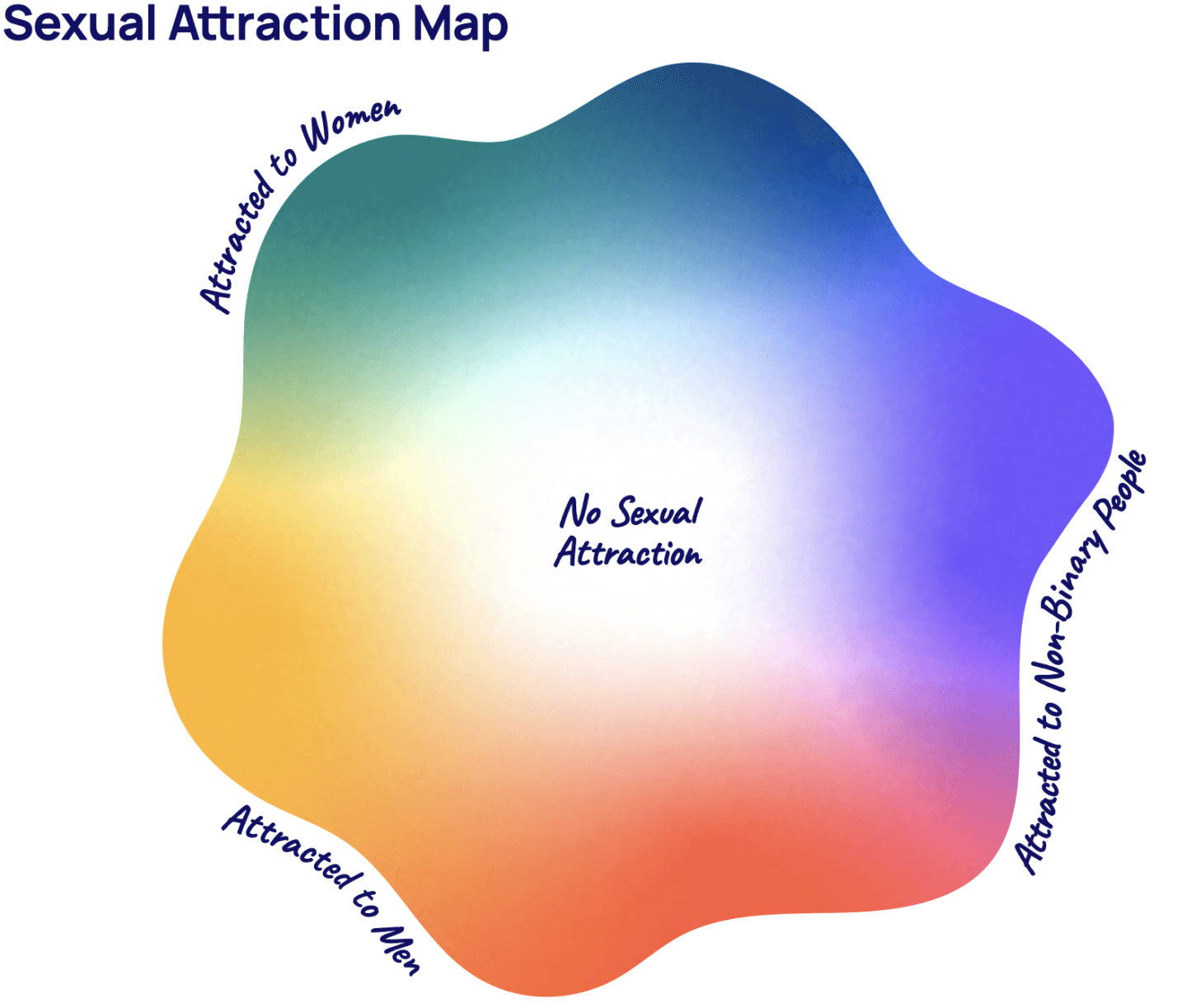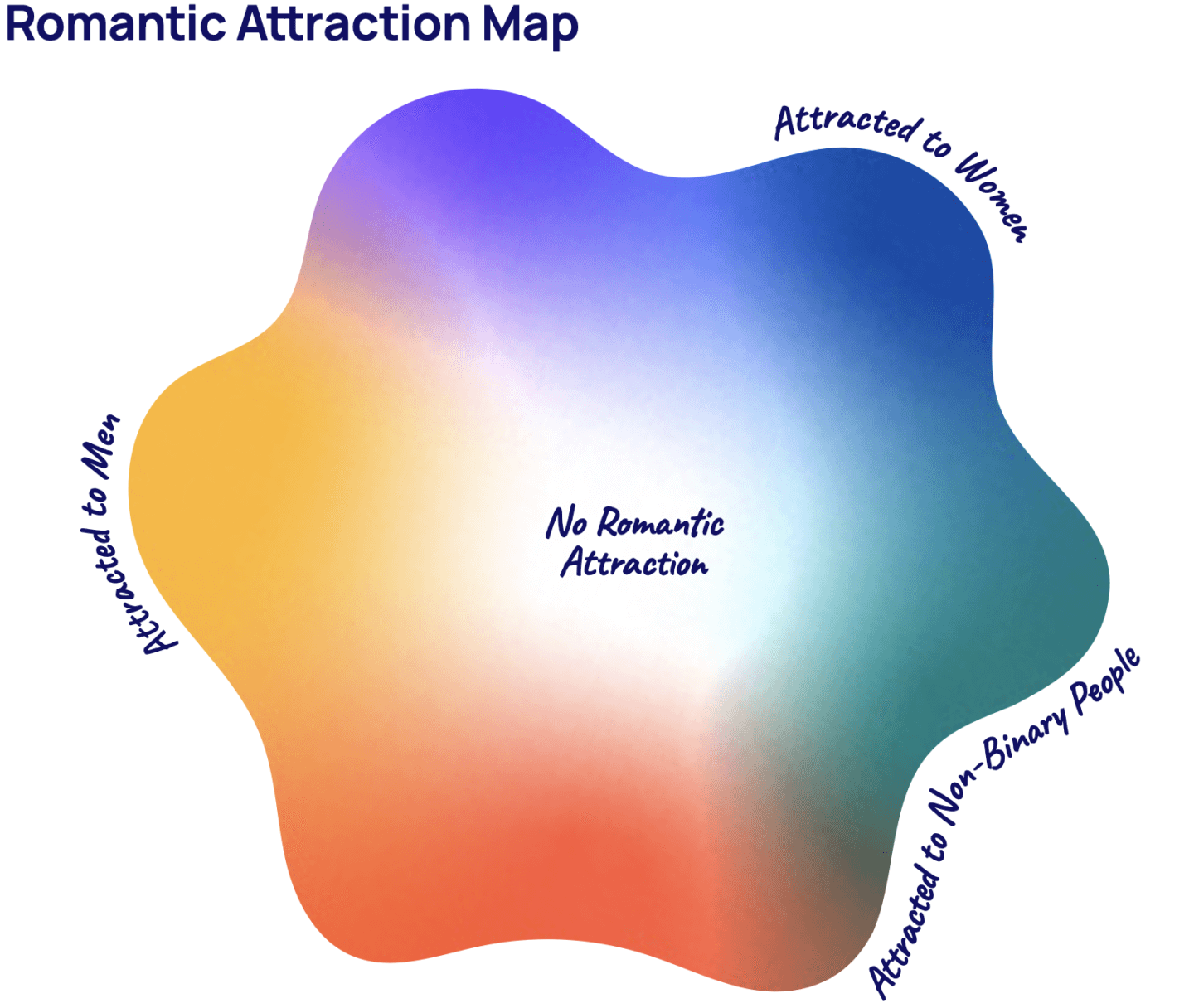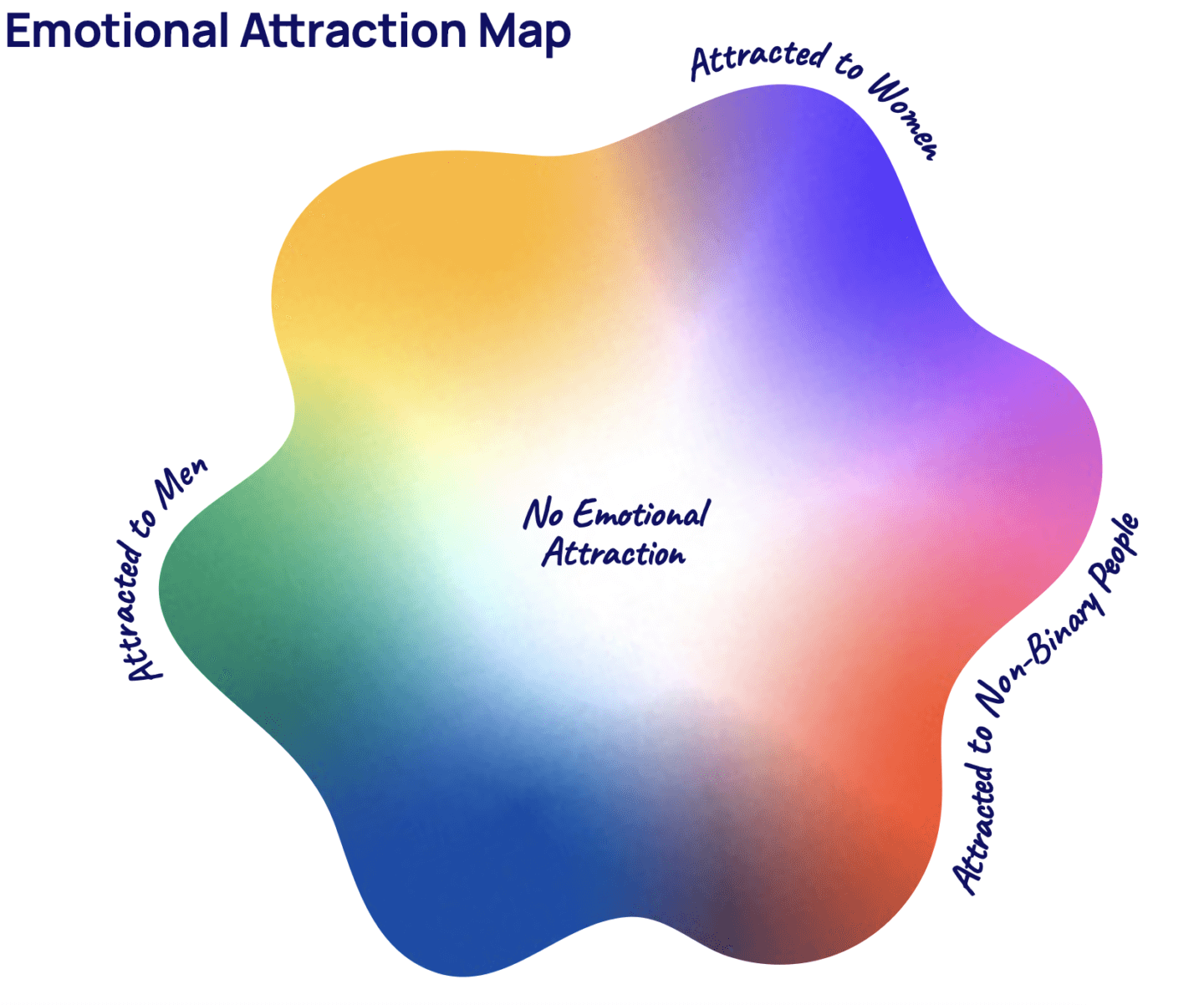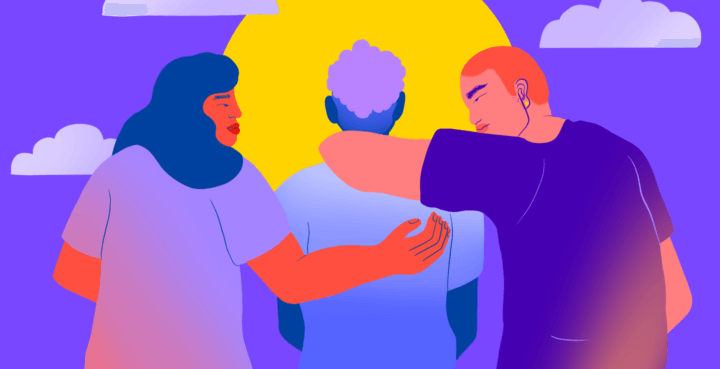Welcome!
Exploring your sexual orientation and/or gender identity can bring up a lot of feelings and questions.
Inside this handbook, we will work together to explore your identity, what it might be like to share your identity with others, and provide you with tools and guiding questions to help you think about what coming out means to you.
You may have heard people talking about “coming out” before in ways that are oversimplified, judgmental, or just plain scary. The truth is that there is no one way to come out or be out. There may be certain people in our lives with whom we want to share our sexual orientation and/ or gender identity, and there may be others with whom we know that we do not feel comfortable or safe sharing. This is more than okay!
I’ve slowly been figuring out who I really am, and every step of the way I like who I find more and more.
HAYLEY, 16, VIRGINA
For a lot of people, coming out doesn’t just happen once. A lot of folks find themselves coming out at different times to different people: with a few friends online, with trusted family members, or just one person in their life.
After thinking it through, you may decide to be out to yourself, but not to anyone else — and that’s okay. Many people choose not to come out to others for different reasons. You are valid and deserve support no matter what.
Identity
Race, ethnicity, (dis)ability, national origin, the language(s) we speak, age, social class, religion/spirituality, and many other identity categories are part of who we are and tell the story of what it’s like to be a unique person. Gender identity and sexual orientation is another piece of that puzzle!
The Basics
Questioning your identity is really common — identity is a complicated thing. If you haven’t figured it out yet, that’s ok! You don’t have to figure it out right now (or ever). Still, taking some time to learn and think through your feelings can help you better understand yourself.
Many people don’t know the differences between gender identity, sex assigned at birth, and sexual orientation. Let’s explore some of these terms and what they might mean to you!
What Is Sex Assigned at Birth?
Sex is a classification of a person as male, female, or intersex. When a baby is born, doctors usually decide whether “female” or “male” will be listed on their birth certificates. This sex assignment at birth is typically based on one’s genitals, however, sex characteristics also include non-visible things like chromosomes and sex hormones.
Every single person is different, and not even sex is just “male” and “female.” Intersex is an umbrella term used to describe variations in physical sex traits or reproductive anatomy that are present at birth or emerge spontaneously later in life, and differ from normative expectations of “male” and “female.”
Sex assignment at birth happens to a child before they can speak, walk, or know themselves. As such, sex assignment does not determine gender. Your true gender identity may be different than the sex a doctor assigned to you, and that is totally valid, normal, and wonderful.
What is Gender?
Some people say that gender looks like this:

Others say gender is this:

In actuality, gender often looks a lot like…:

Gender Identity
Gender describes the internal experience of being a man, a woman, a nonbinary person, or otherwise. Every person experiences gender differently — and you cannot know someone’s gender by simply looking at them.
Commonly known genders include:
- Cisgender: people whose gender identity aligns with the sex they were assigned at birth.
- Transgender: people whose gender identity differs from the sex they were assigned at birth. Some folks might choose to receive certain gender affirming care but this is not necessary and each person should be allowed to choose what works best for themselves.
- Nonbinary: an umbrella term to describe people who experience their gender identity and/or expression outside of the man/woman binary, including folks who are genderfluid, genderqueer, polygender, bigender, demigender, agender, and many others.
- Two-Spirit: an umbrella term created by First Nations/Native American/Indigenous peoples to describe a sexual orientation and/or gender/sex that exists outside of colonial constructions of the gender binary (neither man nor woman, but a distinct, alternative gender status exclusive to their ethnicity). This term should not be appropriated by or used to describe people who are not First Nations/Native American/Indigenous.
Some people have been taught that there are only two genders: man and woman. In fact, people experience gender outside of that binary (meaning made up of two). Think of how many different ways there are to be a person! That means there are just as many ways to experience gender identity.
Exploring your gender identity and self is normal at all ages and at any stage in life.
How do I experience my gender?
How do I feel in relation to the sex I was assigned at birth?
What does gender mean to me?
It can be helpful to visualize. On the next page is a Gender Identity Map where you can mark how you feel — with a single dot, many dots, a circle, anything that feels right. You have the right to mark the map one way today and another way tomorrow, a month, a year from now!

Gender Expression
How do I like to present my gender?
In an ideal situation, how would I want to express my gender?
What aspects of gender expression make me feel happy and authentically myself?
What aspects of gender expression make me feel sad and not like myself?
On the next page is another map for you to decorate: a Gender Expression Map. Remember it is more than okay for your feelings to shift over time. Maybe you present really androgynously (having characteristics that are both masculine and feminine) for a long time. Maybe you present super feminine for a year, and then try more masculine expression. Maybe you fluctuate all the time! Whoever you are, your map reflects the personal relationship you have with your gender expression.

Transitioning
Transitioning looks different for different people, and there is no right way to express your gender. Some people physically and/or medically transition; others do not. This may be related to personal expression, lack of access to gender-affirming healthcare, medical conditions that prevent certain procedures, or other reasons.
Transitioning is more complicated than just a surgery, and can take place over a number of years, involving social, medical, and/or legal aspects of transition. Some people decide not to transition at all. This may be for lack of supportive community, risk to personal safety, or other personal reasons. There is no “right” way to express your gender identity or to live your truth.
What is Sexual Orientation?
Some people say that sexual orientation is this:

Others say sexual orientation is this:

Just like gender, sexual orientation is more expansive too.

Sexual Orientation
Sexual orientation includes different forms of sexual, physical, romantic and emotional attraction, behaviors, and identities. While these are the most commonly known ways of describing orientation, there are other types of attraction as well, including intellectual, sensual, and aesthetic.
In our society, it is often assumed everyone is straight or heterosexual (meaning they are only attracted to people of a different gender). It is also assumed we all experience attraction the same way. Despite what we have been taught, attraction differs from person to person in amazing, unique ways.
You may experience attraction towards people of just one gender, or multiple genders, or different genders at different times in your life. You may not experience attraction at all — also completely valid.
Sexual Attraction
Sexual attraction is typically the first thing that comes to mind when people think about sexual orientation or attraction in general. This type of attraction is characterized by the desire to be sexually intimate with other people. Physical attraction is often considered a piece of sexual attraction. It can be described as who you find physically attractive.
Am I interested in being sexually intimate with others?
Who am I interested in being sexually intimate with?
Who do I find physically attractive?
How often do I experience feelings of sexual/physical attraction?
Feel free to mark how you experience sexual/physical attraction on the Sexual Attraction Map shown on the next page.
You can use the guiding questions about to get you thinking about where you might land on the map.

Romantic Attraction
Romantic attraction is often described as the desire for romantic intimacy or romantic relationships with others. For some, this could mean wanting to hold hands, go on dates, kissing and/or cuddling. The list goes on, and it’s all about how you personally feel around each these expressions of romance.
Have I ever had a crush on someone before?
Who have I had crushes on?
Who do I want to experience romantic behaviors with?
Who do I want to experience relationships with?
Mark on the Romantic Attraction Map on the next page with the ways in which you do or do not feel romantic attraction.

Emotional Attraction
Emotional attraction is characterized by the desire to connect with others on a deep emotional level. This could look like wanting to become best friends with someone or feeling emotionally “drawn” to someone based on their personality.
Who do I have strong desires to be emotionally close to?
Who do I feel an emotional bond towards?
Who do I want to get to know better?
We encourage you to plot out how emotional attraction looks for you on the Emotional Attraction Map on the next page. Where do you find yourself?

Coming Out
Coming out is an incredibly personal decision. There is no right or wrong way to do it — but taking stock of who in your life supports you can make a big difference.
There are lots of different ways to come out:
- Calling someone on the phone
- Sending someone a text
- Sending an email
- Writing a letter
- Talking with someone in person
Planning Ahead
You might decide to take some time to prepare what you want to say. Writing out how you might want to come out to someone can be useful. Practicing with supportive people can also help in figuring out what you want to say and how you want to say it.
How do I want to come out to them?
What would I say to someone I want to come out to?
What would I expect them to say?
Is there a way I would want to prepare prior to coming out?
If you are thinking about coming out, it can be important to think about the range of reactions people may have, including the good ones and the bad ones. Here are some questions to think through how they might react:
What are some of the good responses I may hear?
What are some of the bad responses I may hear?
What do I expect their reactions will be, based on what I know about the person I’m sharing with?
How do I want them to react?
Keep in mind that other people’s reactions can be quite varied.
Testing the Waters
Figuring out how people feel about LGBTQ people and topics can give you an idea about how they might possibly react (though not always).
Some ways that other people have tested the waters:
- Asking how they feel about an LGBTQ celebrity
- Asking how they feel about marriage equality
- Listening to their words: Do they put down LGBTQ people? Do they invoke LGBTQ stereotypes?
- Noticing how they handle difficult emotional events, which can help you guess what reactions to be ready for.
Sometimes the people we come out to ask a lot of questions. It’s okay not to have all the answers; it is not your job to be the expert on your identities. If you feel comfortable, you are always welcome to answer these potential questions, but you don’t owe anyone any information that you aren’t comfortable sharing.
Environment
Timing
There is no perfect time to come out. In fact, the best time will probably change depending on who you want to tell. Sometimes, it is helpful to wait for a time when the person you tell feels relaxed, open, and willing to listen. Other times, you may need to share at a random moment. It is about whenever it feels right to you. Here are some questions to think through to explore timing that might work for you:
What time works best for me to come out?
What time of day feels like a good time to share? (before school, after work, during dinner, etc.)
What time of year feels like a good time to share? (school season, summer, holidays, etc.)
What time works best for the person I want to come out to?
Location
Like timing, there is also no perfect place to come out.
Some places might be safer or more comfortable for you than others.
Would I rather be in a public or private space?
Does home feel like a safe place to talk?
Where would we both be comfortable talking?
Is there a location special to me and the person I’m talking with?
School
Coming out at school can be a great way for some to connect with other LGBTQ classmates. Still, school can be an unsafe place for many people. When thinking about coming out at school, make sure to keep your safety and wellness in mind. You may want to make a safety plan for school if you feel like you might face some tough times.
How would being out at school make me feel?
Who would I want to share with at school?
Are there supportive faculty members, counselors, teachers or adults at my school?
Is there a Gender & Sexuality Alliance (GSA) or similar club/community that I feel comfortable attending?
Are there anti-bullying rules that protect LGBTQ students that are enforced?
Will coming out put my safety at risk? If so, what steps can I take to stay safe?
Support
Think about people in your life who would support you no matter what.
Who do I feel safe with?
Who do I feel comfortable sharing about my life with?
Who in my life has my back no matter what?
Who in my life builds up my confidence?
These supportive people could be:
- Real-life and online friends, classmates
- Team members, school club members, online communities
- Teachers, counselors, doctors, co-workers
- Family members, caretakers, parents, siblings, cousins, neighbors
- Religious or spiritual leaders
Safety Around Coming Out
Sometimes, coming out doesn’t go according to our hopes and plans. If people don’t react the way we wish, it does not reflect on the realness of our identities, and it is not our fault. You deserve to be accepted with open arms, care, and love. In situations where things are feeling unsafe or you expect that they might be, it could make sense to prepare a back-up plan for housing, food, school, and/or transportation, just in case. Your safety and well-being are of the utmost priority. The Trevor Project is always here for you and has your back.
Check out the Resources section below for local and/or online resources that can be a support before, during, and after coming out.
Healthy Relationships
As you explore your identity and coming out, a very important part of that process can be the consideration of dating and/or starting a relationship with special someone(s). With that can come a great deal of excitement and even a bit of anxiety as you get to know someone new.
While navigating this process, it is important to know the difference between a healthy relationship and one that might be unhealthy. Only you can define your expectations, boundaries, and needs. Remember, you reserve the right to express when something doesn’t feel right, and we all deserve to feel safe and secure with people we are dating.
- Healthy relationships can be characterized by trust, honesty, mutual respect, open communication and most importantly feeling safe and secure.
- Unhealthy relationships may be characterized by elements of control, sometimes manifesting physically, emotionally, and/or sexually. Violence, coercion, or force of any kind is not healthy and does not create a safe, respectful space for all partners.
- Consent to engage in sexual, physical, and/or romantic intimacy is extremely important
and must be enthusiastically and freely given by each person. You always have the right
to say no or stop an intimate experience, no matter the reason, no matter if you’ve been intimate with that person before, and no matter if you consented to another behavior earlier. This goes for the person/people you are being intimate with as well. Everyone must consent.
Self Care
Coming out and learning more about yourself can sometimes feel like a roller coaster — full of emotional ups and downs.
To stay healthy, it’s important to discover what helps you feel cared for, relaxed, and able to cope with everything that’s going on. This is called “self-care,” and it’s about taking are of YOU. Coming up with some go-to self-care ideas can be a helpful way to make your mental and physical health a priority.
When I’m having a hard time, what do I do to cope?
What helps me stay healthy, relaxed and positive?
Who could I call, text, or chat with if I need support?
What are my favorite things to do?
What are my goals for the future?
What are some self-care activities I want to try out?
Here are some ideas for a self-care plan:
- Focus on your interest: Do something you enjoy. Write your thoughts out in a journal or create an art project to express your feelings.
- Connect with your body: Take deep breaths. Take a shower or bath. Some people find movement like yoga, walking, or running helpful. You know your body best and what feels good for you.
- Call, text, or chat with a friend for support.
- Talk to a supportive person in your life if you’re feeling sad or unsafe.
- Identify safe places you can go to if you need to get away from a stressful situation.
- Connect with a trained counselor via TrevorLifeline, TrevorText, or TrevorChat.
- Log on to TrevorSpace.org to connect with other LGBTQ young people.
- Put on headphones and listen to your favorite music.
- Watch your favorite TV show and relax.
- Remind yourself that you are a valuable person exactly as you are.
Community Care
Leaning on the people around you is better than going at it alone. There are a lot of ways to get care from your community and provide care for others in your community. Whether that’s by visiting a local LGBTQ center in your area, connecting online with folks, or another way of community building, it can be really beneficial to reach out.
Many LGBTQ Centers1 provide the following services:
- Direct access or referral to LGBTQ-affirming mental and medical health providers, legal services, nonprofit programming, housing/shelter needs, etc.
- Consultation services to assist in program development or incident resolution
- Cultural competency training for agencies, districts, schools, etc.
- LGBTQ-affirming and informed mental health professionals on staff
- Ongoing programming for youth and adults
TrevorSpace is a global online community for LGBTQ young people perfect for making connections and building community.
Checking in on Your Mental Health
Warning Signs
Feeling sad and alone can be overwhelming, especially if people in your life are unsupportive. While these feelings are completely normal, it’s important to keep an eye out for warning signs of larger mental health struggles. You are not alone and asking for help is a sign of strength.
Have You Felt:
- Unimportant
- Alone
- Impulsive
- Suicidal
- Overwhelmed / Unmotivated
- Trapped / Hopeless
- Angry / Irritable
Have You Been:
- Giving away your most valuable possessions
- Losing interest in your favorite things to do
- Planning for death by writing a will or letter
- Eating or sleeping more or less than usual
- Feeling more sick, tire, or achy than usual
- Using drugs or alcohol more than usual
Do You:
- Not care about the future
- Put yourself down (and think you deserve it)
- Plan to say goodbye to important people
- Have a specific plan for suicide
If you answered yes to any of these questions, you can reach out to a trained crisis counselor for support by calling TrevorLifeline (866.488.7386), texting START to 678678 for TrevorText, or by visiting TrevorChat.org — We’re here for you 24/7. You are not alone.
Resources
Gender:
- Gender Spectrum
- TransLifeline
- Trans Youth Family Allies
Legal:
- Lambda Legal
- Human Rights Campaign
Mental Health:
- HelpPRO
- 988SuicidePreventionLifeline
- It Gets Better Project
- Scarleteen
Family and Community:
- Family Acceptance Project
- Gay, Lesbian, Straight Education Network
- GLBT Near Me
- GSA Network
- Parents, Families, and Friends of Lesbians and Gays
- The Institute for Welcoming Resources
- Centerlink
- LGBTQ National Help Center
Trevor Programs
Map Your Own Identity
You can download and print the Gender Identity and Sexual Orientation “Maps” shown in the Basics section of this handbook and fill them out based on how you personally feel right now. It’s okay to not have everything figured out.
It’s also okay if you change your mind and find yourself feeling differently tomorrow, next week, or next year.
The Trevor Project is the leading suicide prevention organization for lesbian, gay, bisexual, transgender, queer, and questioning (LGBTQ) young people.
We provide 24/7 crisis services for LGBTQ young people via a phone lifeline, text, and chat. We also operate innovative research, advocacy, public training, and peer support programs.
Help us continue to provide 24/7 support to LGBTQ+ young people and empower allies to deepen their commitment through advocacy, education, and affirming content.


